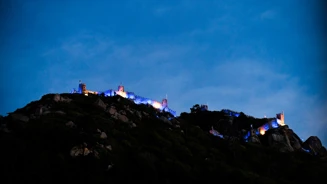A heritage of everyone, for everyone - the influences of the people who have passed (and still pass) through Sintra
08 May 2024

A blue background and 12 small yellow stars. This is how the Moorish Castle appeared on 09 May 2024 to mark Europe Day, a day that celebrates the union between peoples, peace and the promotion of universal values.
Sintra is a unique example of this multiculturalism - Currently, it is the municipality in Portugal with the second highest number of foreigners residing within its territory. According to data from the 2021 Census, there were more than 5,200 European citizens living in Sintra that year, and over 32,500 of other nationalities.
The town’s history shows precisely this spirit of community among peoples. The most obvious example is, of course, the Moorish Castle. Isolated high up in the Sintra Hills, this fortification was founded in the 10th century, a time of Muslim occupation on the Iberian Peninsula. Among its walls it is possible to find evidence of the presence of an Islamic settlement and a Christian settlement, as well as a tomb erected in the 19th century to bury bones collected during the interventions carried out at that time, which features a crescent moon, a cross and the epitaph “What man has brought together, only God can separate”, as there was no way of knowing whether these human remains had been those of Christians or Muslims.
See the National Palace of Sintra as well, the last surviving medieval palace of the Portuguese crown, the decorative elements of which document the local multiculturalism, particularly through the Mudejar style - a happy symbiosis between Christian and Muslim art - evident in the exuberant tile finishes.

The National Palace of Pena also incorporates Gothic and Moorish influences in its architecture, which whisks us into a scene from ‘One Thousand and One Nights’. The Park that surrounds it is 'home' to species from the four corners of the world. Of note are the collections of Asian camellias, introduced by King Ferdinand II in the 1840s and which became the signature of winters at Sintra, being the theme for balls and celebrations.
There is also the Park and Palace of Monserrate. We find species from all of the continents within the park - some spaces even adopt the names of countries, such as the Mexican Garden and the Japanese Garden. Inside the palace, we see exotic motifs, Indian influences, hints of Moorish features, a combination of details from very different communities.

It was this panoply of inspirations that led UNESCO - when classifying the Cultural Landscape as a World Heritage Site - to consider Sintra a unique example of a place that has preserved its fundamental integrity, retaining distinctive features of the successive cultures that occupied it and which still coexist today in harmony. There is, therefore, a preservation of the memories of all the peoples who have always followed and complemented one another here, as evidenced by the eclecticism of their buildings.
